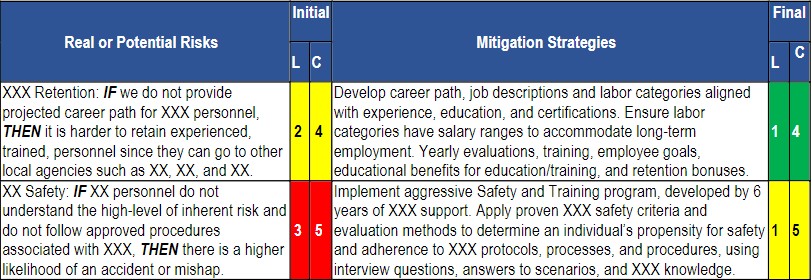2 min read
New OneTeam Features - February 2024
OneTeam users will notice a few new changes beginning February 2024. We released updates and new features to give our...
By: Donna T. Hamby, CP.APMP on Jul 6, 2023 8:00:00 AM

The technical approach is a crucial component of a federal government proposal and can make or break your chances of winning a government contract. In this article, we will discuss what a technical approach is, its importance in government contracting, and how to write an effective technical approach that can help you win government contracts.
The technical approach is a section of a proposal that explains in detail how the proposing organization plans to carry out the work and meet the requirements of the RFP (Request for Proposal). It includes information about the proposed methodology, technical solutions, and any tools or technologies that will be used to execute the contract.
In order to win a government contract, a proposal must demonstrate that the proposing organization has the necessary technical capabilities and expertise to successfully perform the work required by the government agency.
The technical approach is the foundation of a RFP proposal response, and it's crucial to show that your team has all critical success factors and how they are important to the customer. Moreover, the technical approach should highlight the proposing organization's experience and qualifications across the PWS or SOW. This may include information about past projects, certifications, and expertise of the proposed team members.
Here's a step-by-step guide on how to write a technical approach that can help you win government contracts. If the RFP requires that you address five technical areas of the PWS, then you go thru this process and every step for each of the five technical areas. The entire process is addressed separately for each required PWS or SOW element. These sections may be completed by various technical personnel or Subject Matter Experts (SMEs). Be sure and provide the outline below to each author who is writing a technical section and provide instructions that they are to address every element listed.
Show understanding of the Performance Work Statement (PWS) or Statement of Work (SOW) section with introductory statements of how this element fits into the overall contract. Detail the purpose of this contract, why it is important for the customer, and how it helps them meet their mission. Discuss the end objectives or results of the work and how the customer will use them.
Incorporate the win theme or theme statement for this section into your understanding narrative, as it is not a stand-alone heading. Get expert advice on theme statements from Shipley Associates.
Provide a step-by-step guide that describes how the work will be performed. What must the successful contractor have in terms of resources, experience, etc., to complete this work? Refer to the Workflow graphic you developed, but do not repeat every detail. Give the big picture approach and allow the graphic to provide more detail.
Use a flowchart method to diagram the technical workflow for each PWS or SOW element. Include how work comes into the department, how work is assigned to various employees or groups, tools, reference documents, directives, processes, procedures, approvals, quality control checks, reworks, and anything else that will annotate how work is performed. The graphic should break down complex technical tasks into a visual that can be easily understood by technical and nontechnical personnel. Include technical experts to provide inputs to the workflow, review the draft workflow, then revisions to workflow, until all agree that it accurately reflects the work process.
Explain any innovations used in your approach and how they benefit the customer. They can easily be incorporated into your Features/Benefits chart for quick identification.
Explain the tools, methodologies, etc. that you will use to execute this task or PWS section. List brand name of software, existing customer systems and software, industry best practices, like Engineering V Model, ITIL, SCRUM, PMP, etc. Include interface with internal and external customers and groups since they are also defined in terms of function.
Identify internal and external interfaces to complete this PWS work. Also, identify vendor and departmental interfaces. Internal interfaces include within the contract organizational structure and with the prime contractor, and with the supported government staff. External interfaces can include interfaces with other companies executing other contracts for the same customer or agency, and interfaces between various agency directorates or departments and even other government agencies.
Develop a table format for features and benefits to use throughout the proposal. List the Feature of your approach and a corresponding Benefit of that feature. Note, a Benefit must save time, save money, or offer a wanted capability not previously available to the customer. Determine your team strengths during capture strategy development, and include those in the graphic also.

A discriminator is a feature of your proposal or solution that differ from a competitor’s offer - usually a competitor cannot provide the same feature. To be a discriminator, the feature must be important or wanted by the customer. Team discriminators and rationale can be included in the Features & Benefits, and Strengths table.
Detail what quality control methods will be applied to this PWS element. Detail roles and responsibilities of the quality control team and how contract employees will support quality control objectives. Also include how quality is measured and reported for the PWS element.
Use a proven risk identification and mitigation process to identify and record actual or potential risks and describe how they will be mitigated or avoided. The Risk Management Guide for DoD Acquisition provides a great synopsis of risk management. Use a standard 5 x 5 Risk Matrix to assess and categorize potential risks and be sure to list mitigation or avoidance strategies for each risk.

Use an experience example, proof point, or golden nugget to show how well you performed this same work on another contract. The details should include:
The technical approach is a crucial component of a government proposal and must showcase your team's capabilities and expertise to win a contract. By following the step-by-step guide provided in this article, you can write an effective technical approach that highlights your strengths and discriminators and sets you apart from the competition.
This is the 10th in a 11-part series focused on learning about Federal Government contracting and your response to RFPs as a government Contractor. Be sure and download our free graphics resources, including a technical approach workflow graphic that you can edit and use in your next RFP response! Check back each week for another installment in the series. Happy Bidding!
OneTeam is a complete, secure, cloud-native collaboration platform for GovCons to track, qualify, capture, propose and win more contracts with fewer resources by streamlining and automating processes. Our experienced team writes extensively about business development topics and best practices.
Feb 23, 2024 by OneTeam
OneTeam users will notice a few new changes beginning February 2024. We released updates and new features to give our...
Nov 20, 2023 by Donna T. Hamby, CP.APMP
As November approaches each year, our thoughts turn to Thanksgiving with the celebrations of food, family, and...
Aug 23, 2023 by OneTeam
OneTeam users will notice a few new changes beginning August 18, 2023. We released updates and new features to give...